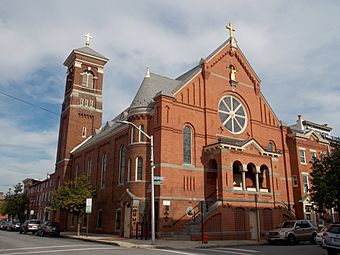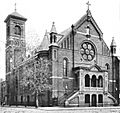St. Leo's Church (Baltimore, Maryland) facts for kids
Quick facts for kids |
|
|
St. Leo's Church
|
|

St. Leo's Church, 2014
|
|
| Location | 227 S. Exeter St., Little Italy, Baltimore, Maryland |
|---|---|
| Area | less than one acre |
| Built | 1880 |
| Architect | E. Francis Baldwin, Edwin Brady |
| Architectural style | Eclectic |
| NRHP reference No. | 83002939 |
| Added to NRHP | July 28, 1983 |
St. Leo's Church is a very old and important Catholic church in Baltimore, Maryland. It is located in a special neighborhood called Little Italy. This church is like the heart of the community there. It has a long history and beautiful design.
Contents
About St. Leo's Church
St. Leo's Church was built a long time ago, between 1880 and 1881. It is made of brick with stone decorations. The church mixes different building styles, like Italianate, Romanesque, and Classical designs.
What Does It Look Like?
The church has a tall entrance porch where you walk in. On one side, there's a round tower with a pointy roof, called a turret. On another corner, there's a square bell tower where bells ring. The front of the church has a big, round window with beautiful patterns, known as a rose window. You can also see lots of cool patterns made with the bricks.
A Special Church for Immigrants
St. Leo's Church is very special because it was one of the first churches in the whole country built just for Italian immigrants. These were people who came to America from Italy to start new lives. The church helped them feel at home and keep their traditions. A famous architect from Baltimore named E. Francis Baldwin designed this amazing building.
A Historic Landmark
Because of its importance and unique design, St. Leo's Church was added to the National Register of Historic Places in 1983. This means it's recognized as a very important historical place in the United States. Inside the church, there's also a historic pipe organ from 1881, made by a company called Niemann.
Images for kids





